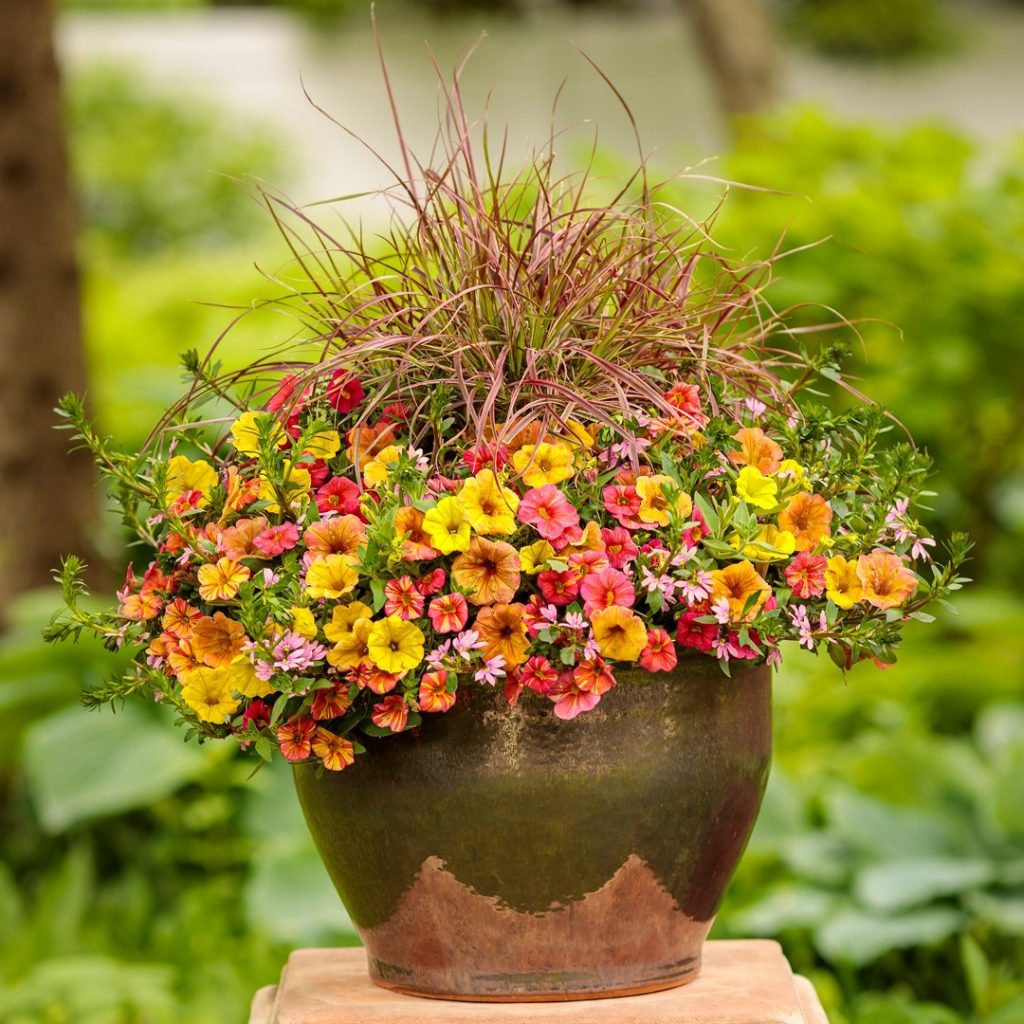A Complete Guide to Growing and Caring for Calibrachoa
Calibrachoa, commonly known as Million Bells®, is a popular choice for gardeners looking to add a burst of color to their outdoor spaces.
This versatile plant is prized for its abundant, trumpet-shaped flowers and its ability to thrive in various growing conditions. Whether you’re a seasoned gardener or a beginner, learning how to grow and care for Calibrachoa can be a rewarding experience.
In this comprehensive guide, we’ll explore everything you need to know about cultivating and maintaining these beautiful plants.
Getting to Know Calibrachoa

Calibrachoa is a genus of plants in the Solanaceae family, which also includes petunias and tomatoes. Native to South America, particularly Brazil and Uruguay, Calibrachoa is often referred to as Million Bells® due to its profusion of small, bell-shaped flowers.
These vibrant blooms come in a wide range of colors, including shades of pink, purple, red, yellow, and white, making them a popular choice for adding visual interest to gardens, hanging baskets, and containers.
Unlike traditional petunias, Calibrachoa plants have a more compact growth habit, making them ideal for cascading over the edges of containers or hanging baskets. They are also known for their exceptional heat tolerance, making them well-suited for sunny summer gardens.
Growing Conditions
When it comes to growing Calibrachoa, providing the right growing conditions is essential for ensuring healthy and vibrant plants. Here are some key factors to consider:
- Sunlight: Calibrachoa thrives in full sun to partial shade. It’s important to provide them with at least 6 hours of sunlight per day for optimal growth and flowering.
- Soil: Well-draining soil is crucial for preventing waterlogged roots, which can lead to root rot. A lightweight potting mix with good drainage is recommended for container-grown Calibrachoa, while garden beds can benefit from the addition of organic matter to improve soil structure.
- Watering: While Calibrachoa plants prefer slightly moist soil, overwatering should be avoided. Allow the soil to dry out slightly between waterings to prevent issues such as fungal diseases and root rot.
- Temperature: Calibrachoa thrives in warm temperatures and is sensitive to frost. It’s best to plant them after the danger of frost has passed and to bring container-grown plants indoors if temperatures drop below 50°F (10°C).
Gorw Calibrachoa From Seeds
Growing Calibrachoa from seed is a rewarding experience that allows you to witness the entire life cycle of this beautiful plant.

Selecting the Right Seeds
Before you can start growing Calibrachoa from seed, you’ll need to obtain the seeds. You can purchase Calibrachoa seeds from your local nursery or garden center, or you can order them online from a reputable seed supplier.
When selecting seeds, look for varieties that appeal to you in terms of color, size, and growth habit. Calibrachoa seeds are available in a wide range of colors, including pink, purple, red, yellow, and white, so take your time to choose the ones that best suit your preferences.
Preparing the Growing Medium
Once you have your Calibrachoa seeds, it’s time to prepare the growing medium. Calibrachoa seeds require a light, well-draining soil mix for germination. You can create your own soil mix by combining equal parts of peat moss, perlite, and vermiculite.
Alternatively, you can purchase a pre-made seed starting mix from your local garden center. Fill a seed tray or small pots with the soil mix, ensuring that it is moist but not waterlogged.
Sowing the Seeds
Now that your growing medium is ready, it’s time to sow the Calibrachoa seeds. Gently press the seeds into the soil surface, but do not cover them with additional soil as they require light for germination.
Mist the soil lightly with water to ensure that the seeds are in good contact with the soil. Place the seed tray or pots in a warm location with indirect sunlight, as Calibrachoa seeds require warmth and light to germinate.
Caring for Seedlings
Once the seeds have germinated, you’ll need to provide proper care for the seedlings. Keep the soil consistently moist but not waterlogged, as excessive moisture can lead to damping off disease.
As the seedlings grow, you can transplant them into individual pots once they develop their first true leaves. Fertilize the seedlings with a diluted liquid fertilizer once a week to promote healthy growth.
Transplanting Outdoors

After the last frost date has passed in your area, you can transplant your Calibrachoa seedlings outdoors. Choose a sunny location with well-draining soil for planting.
Prepare the planting area by amending the soil with organic matter and slow-release fertilizer. Space the seedlings according to the mature size of the variety you are growing, typically 8-12 inches apart.
Calibrachoa Planting Tips
Whether you’re planting Calibrachoa in the ground or in containers, proper planting techniques are essential for establishing healthy plants. Here’s how to plant Calibrachoa:
- Choose a location with well-draining soil and ample sunlight.
- If planting in the ground, space Calibrachoa plants approximately 8-12 inches apart to allow for adequate air circulation.
- For container planting, select a pot with drainage holes and fill it with a lightweight potting mix.
- Gently remove the Calibrachoa plant from its nursery container and loosen the roots before planting.
- Plant the Calibrachoa at the same depth as it was in the nursery container and water thoroughly after planting.
Caring for Calibrachoa
Once your Calibrachoa plants are established, proper care is essential for promoting continuous blooming and healthy growth. Here are some tips for caring for Calibrachoa:
- Deadheading: Regular deadheading, or the removal of spent flowers, can encourage continuous blooming throughout the growing season.
- Fertilization: Feed your Calibrachoa plants with a balanced fertilizer every 2-4 weeks to support healthy growth and abundant flowering.
- Pruning: Occasional pruning can help maintain a compact growth habit and encourage branching, resulting in a fuller plant with more flowers.
- Pests and Diseases: Keep an eye out for common pests such as aphids and spider mites, and promptly address any signs of disease such as powdery mildew or botrytis.
Pest and Disease Control
While Calibrachoa is relatively resistant to pests and diseases, it’s important to monitor your plants for any signs of trouble. Keep an eye out for common pests such as aphids and spider mites, and treat infestations promptly with insecticidal soap or neem oil.
Additionally, ensure good air circulation around the plants to prevent issues such as powdery mildew.
Overwintering Calibrachoa
In regions with cold winters, overwintering Calibrachoa plants can help ensure their survival for the following growing season. Here’s how to overwinter Calibrachoa:
- In late fall, before the first frost, bring container-grown Calibrachoa plants indoors to a cool but frost-free location, such as a garage or basement.
- Cut back the foliage and reduce watering to allow the plants to enter a dormant state.
- Monitor the plants for signs of new growth and resume regular watering in early spring once the danger of frost has passed.
By following these overwintering steps, you can protect your Calibrachoa plants from cold damage and enjoy their vibrant blooms for years to come.
Conclusion
Calibrachoa (Million Bells®) is a stunning addition to any garden or outdoor space, offering an abundance of colorful flowers and a compact growth habit. By providing the right growing conditions, proper planting techniques, and ongoing care, you can enjoy the beauty of Calibrachoa throughout the growing season.
Whether you’re adorning your patio with hanging baskets of Million Bells® or creating colorful borders in your garden beds, these versatile plants are sure to make a lasting impression.
With their easy-going nature and vibrant blooms, Calibrachoa is an excellent choice for both beginner and experienced gardeners alike.





